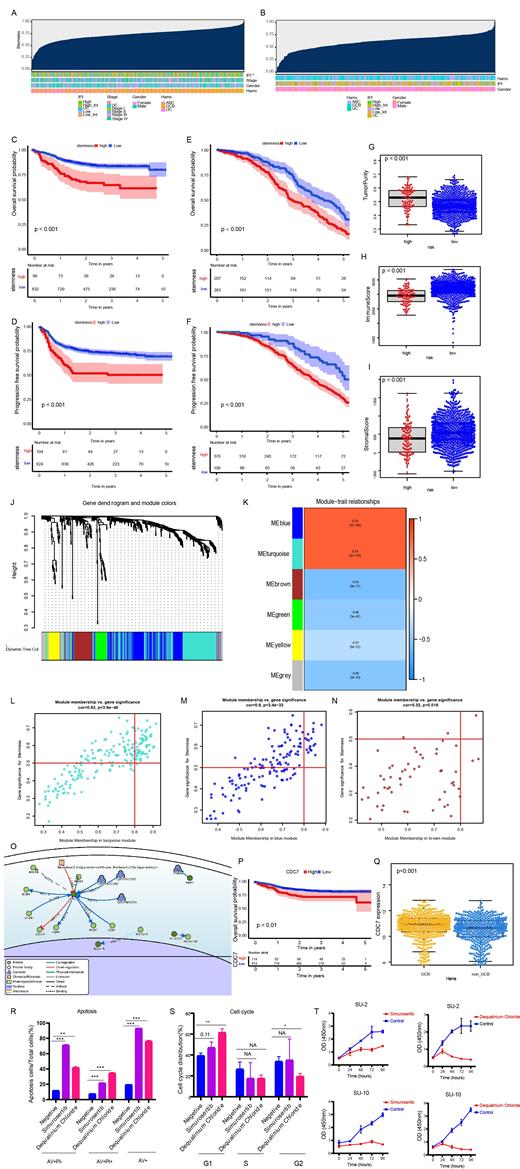Abstract
Background: Mounting studies have shown that tumor cells have stem cell-like phenotypes called stemness. The stemness on prognosis and the immunological properties of diffuse large B-cell lymphoma (DLBCL) has not been systematically explored. This study aimed to explore the relationship between stemness, prognosis and immune microenvironment and further to identified potential therapeutic target related to stemness.
Methods: The gene expression and clinical information of 1398 diffuse large B-cell lymphoma sample were obtained to calculated stemness based on the single-sample gene set enrichment analysis (ssGSEA). Survival analysis was performed for stemness phenotypes and the association of stemness with clinical features was assessed further. Weighted gene co-expression network analysis (WGCNA) to screen the relevant key genes systematically for stemness of DLBCL. Cell cycle assay and apoptosis assay were used to evaluate the role of cell division cycle 7 (CDC7) inhibitors in DLBCL cell lines.
Results: Stemness was significantly associated with overall survival (OS) and progress free survival (PFS) of DLBCL patients. Notably, prolonged OS and PFS was observed in low stemness groups compared to high group, and the international prognostic index (IPI) with a high risk had higher stemness. Furthermore, DLBCL stemness were associated with tumor purity, immune score and stroma score. From stemness module, 16 genes in the co-expression were chosen as key genes and further identified CDC7 as candidate target gene for antitumor. CDC7 inhibitors involving in dequalinium chloride which was approved by Food and Drug Administration (FDA) for anti-microbial and simurosertib which in a phase I clinical trial for multiple solid tumors show antitumor in DLBCL cell line of SU-DHL-2 and SU-DHL-10.
Conclusion: In a word, the study integrated DLBCL stemness, clinical characteristics and immunophenotyping, providing an idea of targeting for cold tumors of DLBCL, and also verified the efficacy of inhibitors of key gene of stemness CDC7 in DLBCL. It is significant to develop novel therapeutic targets for diffuse large B cell lymphoma.
Figure Legends:
Figure (A-B) An overview of the association between known clinical and molecular features (IPI, Hams, gender, and stage) and stemness index in DLBCL cohort. Columns represent samples sorted by stemness index from low to high (top row). Rows represent known clinical and molecular. (C-D) Overall survival and progression free survival of stemness index in DLBCL patients of GSE117556 by Kaplan-Meier analysis. (E-F) Overall survival and progression free survival of stemness index in DLBCL patients of GSE31312 by Kaplan-Meier analysis. (G-I) Boxplots of tumor purity, immune score, stromal score in individual samples stratified by stemness index. (J) WGCNA analysis of differentially expressed genes in DLBCL. Different colors correspond to related modules. (K) Correlation coefficient between the modules and clinical traits with stemness. P-values are listed in the modules. (L-N) Scatter plot analysis of different modules in the MEblue, MEbrown, and MEturquoise modules. (O) Signor analysis of 16 key genes in DisNor. (P) K-M curves of the expression of CDC7 for the DLBCL patients. (Q) Boxplots of the expression of CDC7 in individual samples stratified by Hams. (R) Apoptosis ratio of SU-DHL-10 cells were treated with dequalinium chloride and simurosertib for 48 h. Data are mean ± SD of triplicate experiments. For dequalinium chloride and simurosertib compared with control an unpairedt-test was used. (S) Cell cycle of SU-DHL-10 cells were treated with dequalinium chloride and simurosertib for 48 h. Data are mean ± SD of triplicate experiments. For dequalinium chloride and simurosertib compared with control an unpairedt-test was used. (T) Cell viability of SU-DHL-2 and SU-DHL-10 cells treated with dequalinium chloride and simurosertib at the IC50 concentrations. * p<0.05. ** p<0.01, *** p<0.001.
No relevant conflicts of interest to declare.


This feature is available to Subscribers Only
Sign In or Create an Account Close Modal